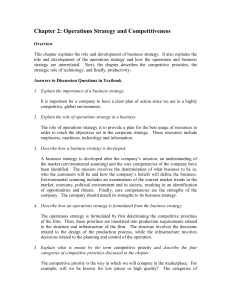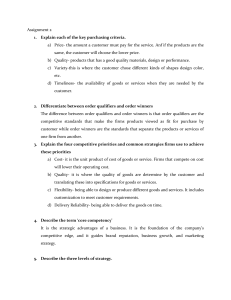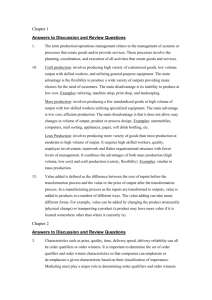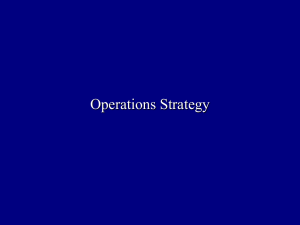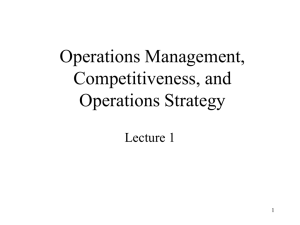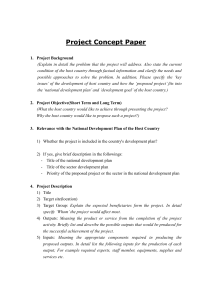Chapter 2: Operations Strategy and Competitiveness
advertisement
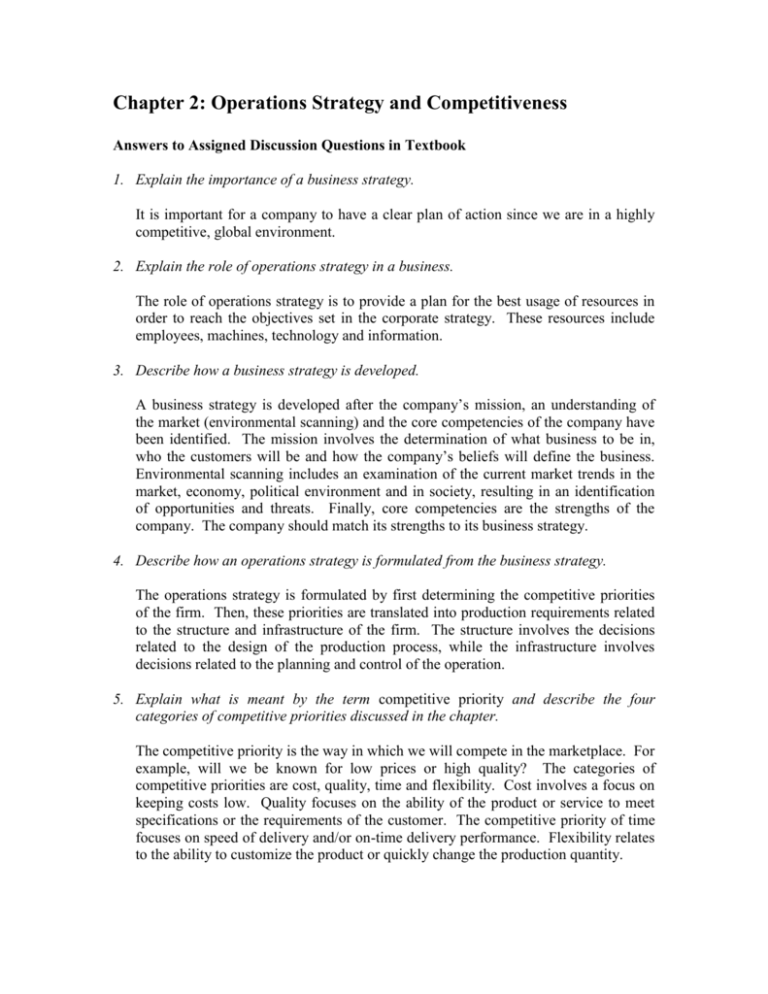
Chapter 2: Operations Strategy and Competitiveness Answers to Assigned Discussion Questions in Textbook 1. Explain the importance of a business strategy. It is important for a company to have a clear plan of action since we are in a highly competitive, global environment. 2. Explain the role of operations strategy in a business. The role of operations strategy is to provide a plan for the best usage of resources in order to reach the objectives set in the corporate strategy. These resources include employees, machines, technology and information. 3. Describe how a business strategy is developed. A business strategy is developed after the company’s mission, an understanding of the market (environmental scanning) and the core competencies of the company have been identified. The mission involves the determination of what business to be in, who the customers will be and how the company’s beliefs will define the business. Environmental scanning includes an examination of the current market trends in the market, economy, political environment and in society, resulting in an identification of opportunities and threats. Finally, core competencies are the strengths of the company. The company should match its strengths to its business strategy. 4. Describe how an operations strategy is formulated from the business strategy. The operations strategy is formulated by first determining the competitive priorities of the firm. Then, these priorities are translated into production requirements related to the structure and infrastructure of the firm. The structure involves the decisions related to the design of the production process, while the infrastructure involves decisions related to the planning and control of the operation. 5. Explain what is meant by the term competitive priority and describe the four categories of competitive priorities discussed in the chapter. The competitive priority is the way in which we will compete in the marketplace. For example, will we be known for low prices or high quality? The categories of competitive priorities are cost, quality, time and flexibility. Cost involves a focus on keeping costs low. Quality focuses on the ability of the product or service to meet specifications or the requirements of the customer. The competitive priority of time focuses on speed of delivery and/or on-time delivery performance. Flexibility relates to the ability to customize the product or quickly change the production quantity. 6. Find an example of a company that makes quality its competitive priority. Find another company that makes time its competitive priority. Compare these strategies. Toyota focuses on producing a quality car. It has one of the lowest defect rates in the industry. LensCrafters promises to make your glasses in one hour or less. So they have focused on the speed of delivery. 7. What is meant by the terms order qualifiers and order winners? Explain why they are important. Order qualifiers are competitive priorities for which we must reach some minimum target in order to be qualified to sell in that market. Order winners are those competitive priorities that will help us win orders. It is important to understand whether competitive priorities are order qualifiers or order winners since our decisions about priorities will determine our level of success. 8. Describe the three types of technologies. Explain the strategic role of technology. The three primary types of technologies are: product technology, process technology, and information technology. Product technology, new technology developed by a firm, allows it to offer improved products. New generations of cellular telephones are a current example. Process technology allows a firm to create goods and services more effectively. Cash register scanners are an example where supermarkets can process customers through the checkout line faster and keep better records of items sold. Information technology impacts communication and information collection and processing. An example of improved operations through this technology would be cross docking. These technologies improve products, processes, and coordination. Effective use of emerging technologies can give a firm a competitive advantage. As competitive approach is a strategic decisions, so is the use of technology. 9. Describe the meaning of productivity. Why is it important? Productivity measures how well we turn our inputs into outputs. For example, can one automobile manufacturer produce more cars of the same size per factory employee? Productivity is important because it determines our cost structure. 10. Explain the three types of productivity measures. The three types of productivity measures are total productivity, partial productivity and multifactor productivity. Total productivity utilizes all inputs and outputs in the calculation. Therefore, we are calculating the entire organization’s productivity. Partial productivity involves calculating the productivity for only one type of input, such as machines, labor or materials. Finally, multifactor productivity is the ratio of outputs to inputs for several, but not all, types of inputs.
